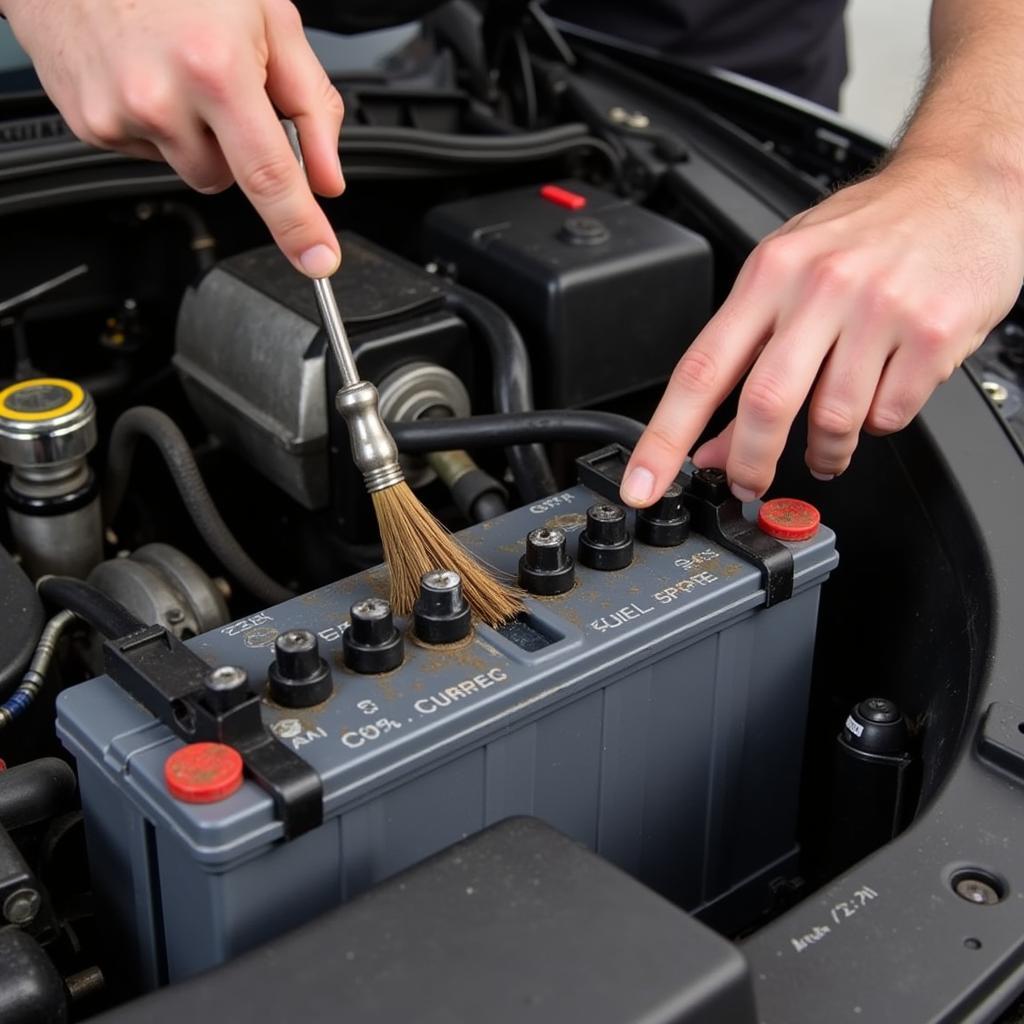A dead car battery is frustrating, especially when the car was turned off. This “battery drain car turned off” phenomenon can be caused by several factors, from faulty components to parasitic draws. This guide explores the common causes, diagnostic steps, and solutions for this pervasive automotive issue. Let’s dive in and get your car back on the road!
Understanding Why Your Car Battery Drains When Off
A car battery’s primary function is to start the engine. Once the engine is running, the alternator takes over, providing power to the vehicle’s electrical systems and recharging the battery. However, even when the car is off, certain systems, like the clock, alarm, and radio presets, continue to draw a small amount of power. This is normal. The problem arises when a faulty component or system draws excessive power, leading to a “battery drain car turned off” situation.
2012 infiniti qx56 battery problems
Common Culprits Behind Battery Drain
Several components can be responsible for excessive battery drain when the car is off. These include:
- Faulty alternator: While the alternator charges the battery when the engine is running, a failing alternator can also drain the battery when the engine is off.
- Parasitic draw: This refers to the current drawn by electrical components even when they’re supposed to be off. Common culprits include interior lights, glove box lights, faulty door switches, and aftermarket accessories.
- Bad battery: A failing battery may not hold a charge properly, even if the charging system is functioning correctly.
- Corroded battery terminals: Corrosion on the battery terminals can disrupt the flow of electricity and contribute to battery drain.
 Checking car battery terminals for corrosion
Checking car battery terminals for corrosion
Diagnosing a Battery Drain
Identifying the source of the drain is crucial. Here’s a step-by-step guide:
- Test the battery: Use a multimeter to check the battery voltage. A fully charged battery should read around 12.6 volts.
- Check for parasitic draw: With the engine off and all accessories turned off, use a multimeter to measure the current draw between the negative battery terminal and the negative battery cable. A draw of over 50 milliamps may indicate a problem.
- Isolate the circuit: Remove fuses one by one while monitoring the multimeter. When the current draw drops significantly, you’ve identified the problematic circuit.
- Inspect the components: Once you’ve identified the circuit, inspect the components within that circuit for faults.
How can I tell if my alternator is draining my battery?
A simple test involves disconnecting the negative battery cable while the engine is running. If the engine stalls, the alternator is likely the culprit. However, this is a rudimentary test and further diagnosis may be required.
battery draining while car is off
Fixing the Battery Drain Issue
Once you’ve pinpointed the cause of the battery drain, you can take appropriate action:
- Replace a faulty alternator: If the alternator is the culprit, replacement is typically the best solution.
- Repair or replace faulty components: Address any faulty components causing parasitic draw, such as faulty door switches, relays, or aftermarket accessories.
- Clean corroded battery terminals: Clean the terminals with a wire brush and baking soda solution.
- Replace the battery: If the battery is old or failing, replacement is necessary.
“A simple loose connection can lead to a significant battery drain. Always double-check your work after any electrical repair,” advises John Smith, Automotive Electrical Engineer at Advanced Auto Solutions.
Preventing Future Battery Drain Problems
Regular maintenance can help prevent future battery drain issues:
- Regularly inspect your battery and terminals: Look for signs of corrosion or damage.
- Limit the use of accessories when the engine is off: Avoid leaving lights, radio, or other accessories on for extended periods when the car isn’t running.
- Have your car’s electrical system checked periodically by a qualified mechanic: This can help identify potential problems before they become major issues.
“Preventive maintenance is key to a healthy car battery. Regular checks can save you time, money, and frustration in the long run,” adds Jane Doe, Lead Technician at AutoTech Experts.
Conclusion
A “battery drain car turned off” situation can be a nuisance, but with the right diagnostic approach and solutions, you can get your car back in working order. Remember, regular maintenance is crucial for preventing future battery drain issues. By understanding the common causes, performing regular checks, and addressing problems promptly, you can ensure your car battery stays charged and ready to go.
FAQ
- How long does a car battery last? Typically, a car battery lasts between 3 and 5 years.
- Can extreme temperatures affect battery life? Yes, both extreme heat and cold can shorten battery life.
- Is it safe to jump-start a car with a dead battery? Yes, it’s generally safe if done correctly.
- What are the signs of a failing alternator? Dim headlights, flickering dashboard lights, and a whining noise from the engine are common signs.
- How can I test my car battery? You can use a multimeter to check the battery voltage.
- Can a faulty car alarm drain the battery? Yes, a malfunctioning car alarm can contribute to battery drain.
- Should I disconnect my battery if I’m not using my car for a long time? It’s generally recommended to disconnect the negative battery cable if you’re storing your car for an extended period.


